In this week's lecture Professor Vesna discussed the combination of medicine technology and art. The advancements in modern technology has lent itself to the rapid advances of technology in medicine. Technology often has allowed for seeing the inside of the human body. However, before the advancements of technology, art has had to play a large role in understanding how the human body works. In order to see the skeleton of a human without a camera or any other technology, images of the human body had to be drawn by hand.
 |
| Imaging of the human body, skeleton and muscles |
 |
| Tommy John Surgery area for baseball players. |
 |
| RFID chip next to a grain of rice |
Brandon, John. "Is There a Microchip Implant in Your Future?" Fox News. FOX News Network, 30 Aug. 2014. Web. 27 Apr. 2015.
"ObamaCare Implant: ObamaCare Microchip RFID Myth." Obamacare Facts. N.p., n.d. Web. 27 Apr. 2015.
Vesna, Victoria. “Http://www.youtube.com/v/Ep0M2bOM9Tk.” Lecture. Medicine pt1 . Youtube, 21 Apr. 2012. Web. 25 Oct. 2012. <http://www.youtube.com/watch?v=Ep0M2bOM9Tk>.
Vesna, Victoria. “Http://www.youtube.com/v/FIX-9mXd3Y4.” Lecture. Medicine pt3. Youtube, 22 Apr. 2012. Web. 25 Oct. 2012. <http://www.youtube.com/watch?v=FIX-9mXd3Y4>.
Vesna, Victoria. “Http://www.youtube.com/v/psjnQarHOqQ.” Lecture. Medicine pt2 . Youtube, 21 Apr. 2012. Web. 25 Oct. 2012. <http://www.youtube.com/watch?v=psjnQarHOqQ>.







